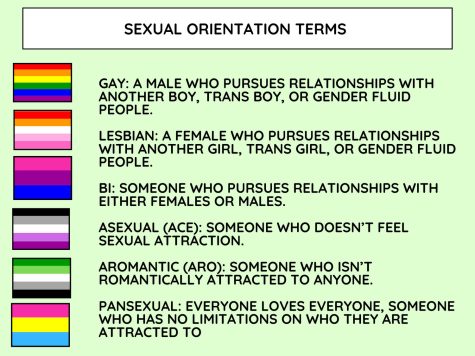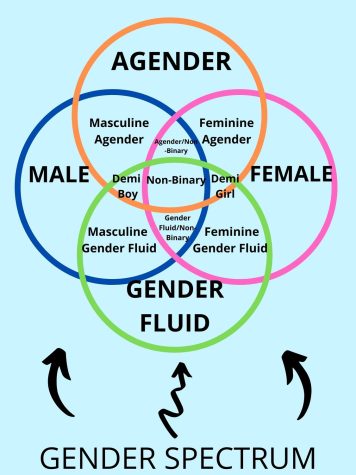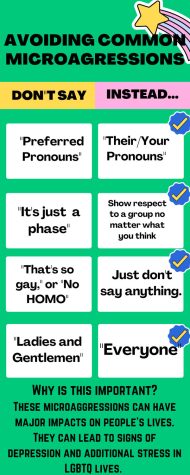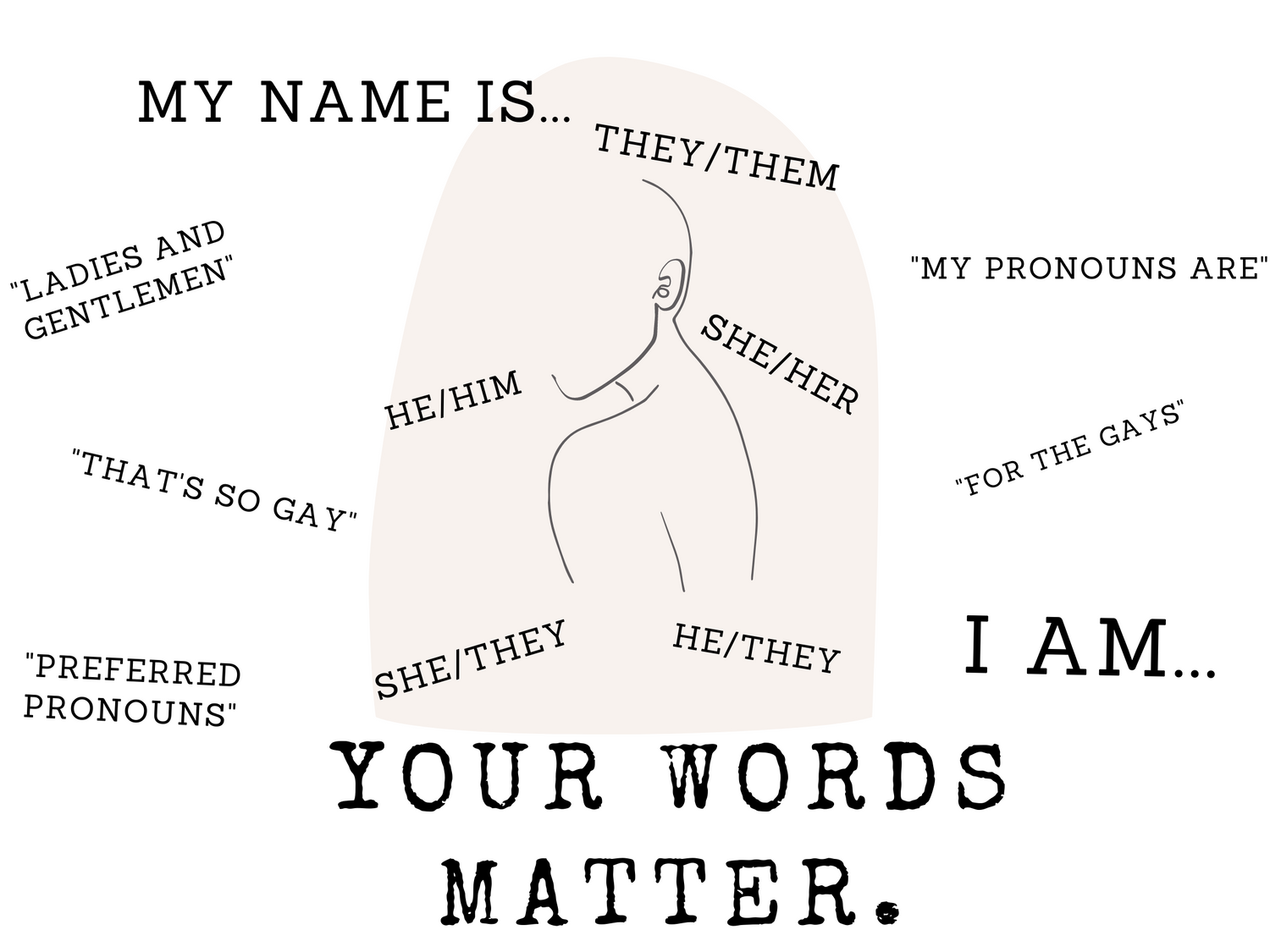Your words matter: expanding knowledge about the LGBTQ+ community.
November 14, 2021
Growing up, I was close with a lot of people who changed their sexual or gender orientations. I was excited to grow and support people with their identity changes. Although changing pronouns and names of people who had been in my life for so long was a weird and a long transition for me, as someone who is only an ally I cannot imagine what those changes felt like for them. What I do know is that gender and sexual orientation play an important role in someone’s identity, using the correct pronouns is one of the most important things you can do to support someone in the LGBTQ community. The main things people of the LGBTQ+ community ask for is equality and respect.
Gender Orientation and Sexual Orientation

Education is an important part of forming opinions. Before learning how gender and sexual orientations are different and comparing them, let’s look at them separately.
“Gender orientation relates to who you are and your emotional connection to your identity, not the way or state you were born,” junior and co-leader of Gender Sexuality Alliance (GSA) Club Juniper (Bella) Neisius said.
Genderism is a belief that gender is composed of two distinct and opposite genders, women and men, in which there is no overlap. Now, we know that’s not the case. Scientist Cade Hildreth explains that gender can’t be binary because it is a socially structured, personal identity. In other words, there are people that exist between the female and male gender identities, and there are not only two genders. Although in the past, society has believed in the concept that there are two genders, our world is constantly changing, and people are constantly changing too. Someone can also go through many labels when finding a sense of self-identity.

And although I have tried to provide definitions above to help increase understanding of different genders and sexualities, there are no strict borders on what classifies as what. What is important to know is these titles are chosen by each specific person. For example, the difference between bi and pansexual is nuanced and could be purely based on which title the person feels the most comfortable using.
Gender is a broad term that relates to everyone on a spectrum and embodies each and every individual person and how they act in society. Meanwhile, sexual orientation is based on what type of sexual attraction someone feels towards another person, and romantic orientation is based on what type of romantic attraction someone feels.

One junior identifies as aromantic and asexual but wishes to remain anonymous. She explains the difference between sexual and romantic attraction as the words themselves. Sexual attraction is how you sexually feel toward someone, while romantic attraction is how you feel romantically towards someone. Someone who is asexual may still have romantic relationships or ‘crushes,’ and someone who is aromantic may still have sexual relationships.
“[As someone who identifies as pansexual,] I don’t like a person based on their gender but based on how we interact. I don’t feel more attracted to one gender over another,” Neisius said. “[I like someone] for who they are and who they identify as.”
Teachers in Parkway have had training on different terms that relate to the LGBTQ+ community. Principal Dr. Jeremy Mitchell also reports that the district has enacted new procedures to help students of all minorities feel safe.
Hildreth confirmed that both gender orientation and sexual orientation exist as a spectrum. Scientists in neuroscience, reproductive science and biology have confirmed this belief.
“This should not be a place where you have to worry about some outside influence. We want every student to walk around the halls, get a good education and enjoy themselves. School isn’t always fun but we also don’t want students to feel like they can’t be themselves,” Mitchell said.
Pronouns and Name Changes
Pronouns relate closely to gender orientation because normally pronouns coordinate with the gender you identify as. For example, Neisius identifies as non-binary which means they don’t always choose a specific gender, so they use they/them pronouns. However, this may not always be based on gender, sometimes pronouns can be based on how an individual feels in a certain environment.
“I don’t feel like a female or a male, I feel like I am in just between. That’s why there are multiple genders,” Neisius said.
Because non-binary or gender-fluid people do not identify within a rigid definition of gender, some days they may feel more like a male, and others they may feel like a female, or they may feel anywhere in between.
On the other hand, sophomore and co-leader of GSA Club Caitlyn Allendorph is cis-gendered and uses she/her pronouns. Some people in the LGBTQ+ community identify as cis-gendered, which means they identify the same gender as their birth gender, they can use varying pronouns.
Junior Quinn Gillies (he/they) wears a mask to school that has his pronouns as the design, they do this to help ease communication about his pronouns, and help others know which pronouns he wants people to refer to him by.
“I definitely get stares because of it,” Gillies said. “But on the other hand, it is an easy way to come out to people or make people aware of your pronouns, without having to constantly tell or remind people, the mask does it for me.”
When someone changes their name, their previous name is now called a dead name. It is important to know the correct names to use and when to use them. If someone shares a new name with you and they aren’t fully out to a specific group of people, they may want their dead names used, and other times they may not. So when someone tells you they have had a name change, you should ask them when they want that name used and when to use their dead name.
A survey mentioned in an article by Center of American Progress reported that 70.4 percent of LGBTQ+ members experienced some sort of discrimination in the last year that originated from their gender or sexual identification.
“It’s upsetting to see the discrimination, but it happens anyway. It’s hard to stop one person from doing it when it ends up spiraling down a long, long, trail of talking back and forth about the same issues over and over again with someone,” Neisius said.
Microaggressions

Believe it or not, people still say “that’s so gay.” Even if it is just a saying, these little phrases can negatively affect someone in the LGBTQ+ community. There are many ways to help and hurt the community. The way you phrase your sentences and the tone in which you say your words are vitally important to this community.
Starting with genders, do not make assumptions. One of the ‘jokes’ that spread through our middle school classrooms directly impacted people of the LGBTQ community. Asking someone if they were assuming your gender produced little giggles throughout our seventh and eighth-grade classrooms, but this is a serious thing. Do not assume genders of peers, if you are unsure of someone’s pronouns, you should find a way to respectfully ask them which pronouns they use.
When referring to someone’s pronouns, what you say can be hurtful to members of the LGBTQ+ community. For example, while interviewing and researching for this article, I would ask people what their preferred pronouns are for the purpose of the article. I quickly figured out that what I said was incorrect. A lot of people refer to a change in pronouns as “preferred pronouns,” and this can be considered as a microaggression because of the implication that the ‘preferred pronouns’ aren’t the ‘correct’ pronouns. When I was saying ‘preferred pronouns,’ I wasn’t purposely trying to sound passive-aggressive, I was just trying to communicate in a language I didn’t fully understand.
Someone may use different pronouns. For example, someone who is non-binary or gender fluid may use he/they pronouns. Normally, this means they are interchangeable, but it could also mean some days they feel more masculine and some days they feel more neutral on the gender spectrum. They can identify using different pronouns on different days, months, or across a span of years. Normally, during these pronoun changes, the person would tell you. However, if someone were to change their pronouns, it can be exhausting to tell each person they come across that they are changing their pronouns, so when communicating with someone who is non-binary or gender fluid, a way to ease that communication would be to every once and a while just ask them what pronouns they are currently using.
It is also important to remember that the use of pronouns can also be based on how comfortable a person is in a specific setting or around certain people, so it is also important to ask when you can use specific pronouns. When people disclose their pronouns to you, it can be a good deal to them and you don’t want to use specific pronouns around people they may not feel comfortable with.
People in the LGBTQ+ community aren’t asking you to be perfect. If you mess up on a name or pronoun, just apologize and correct yourself. If you are unsure, ask what they prefer. The common theme is respect.
Getting ready for school, Gillies decided to wear a shirt that says: “Error: gender not found.” He said that he got weird looks and rude comments about the shirt. Gillies even felt like they needed to wear a hoodie over the shirt in the hallway. The bottom line is facial expressions can be microaggressions as well.
“The discrimination sucks because there’s no reason for it,” Gillies said. “Just because people don’t like things that are different doesn’t mean that you shouldn’t be respectful.”
How can we support the LGBTQ+ community?
Only 20 states have laws against bullying on the grounds of sexual orientation and gender identity, and Missouri isn’t one of them. This provides space for exclusion and discrimination against LGBTQ students. This means we need to work extra hard to support them socially because of the lack of legal support across the country.
Even if you are not a part of the LGBTQ+ community, there are many things you can do to help support them. Teachers can visually and physically show support to the LGBTQ+ community through signs or posters in your classroom, and address class expectations that could surround the LGBTQ+ community. Use inclusive words. For example, say “everyone” instead of “ladies and gentlemen” when addressing a group. This helps to better include the gender fluid, agender and non-binary students in the school.
Another way that teachers specifically can help people in the LGBTQ+ community is by making a simple Google form.
For three years now, Theater teacher Amie Gossett created a Google form for students to fill out at the beginning of each semester. On the form, Gossett asks her students for their pronouns, name(s) and when the different scenarios that it is okay to use. Gossett also includes a question at the end which asks students if they want to have any further discussion about gender or pronouns, and when it is okay to use specific pronouns.
“I wanted to make sure students knew that if they wanted to use specific pronouns in the classroom that they are safe to do so,” Gossett said. “This helps me relate to them and be able to represent how they identify because I think that is most important in the classroom. I want them to be as comfortable as possible here. I want to take that uneasiness off the table. My thing is everyone is accepted, so why not make students as comfortable as possible.”
For example, some students would be okay using pronouns in class but not in front of parents. Or maybe they only want to have those pronouns used in direct and private conversations. This is also why it is important to use this as some kind of worksheet and not a discussion with the whole class, because students who don’t want to be out to a large group of people may feel like they have to lie about pronouns.
Teachers aren’t the only people who can make a difference in the lives of members of the LGBTQ+ community. Students, if you use the correct pronouns, respect personal boundaries, and treat everyone equally, you are helping out just as much as a teacher who creates an equal opportunity classroom. Treat everyone equally because they are important and they matter.
Something that everyone can do is self-educate! Reading this article is a great start to your research. If you don’t understand something, Google it or respectfully ask someone you know who is in the LGBTQ+ community. But at the same time, it is important to respect people and their boundaries. So with general questions, you want to respect other people’s time and see if you can find an answer online before asking someone.
Know what pronouns to use for yourself and others and respect when people want their names used and their dead names used. When you ask a person their pronouns and when to use them respectfully, they will appreciate it more than you think. And finally, avoid microaggressions that could negatively impact someone and choose your words wisely. So, what can be done to better understand and support the LGBTQ+ community? When you meet someone new or are introduced to a new culture, you should be respectful, self-educate (research) and ask questions. A great place to ask additional questions would be at GSA Club on Wednesdays during Ac Lab 1st Module.
“No matter who you are or what you believe in, helping people and showing kindness can go a long way,” Allendorph said.


Keefer • Feb 3, 2022 at 7:48 am
I would love to hear more on how you respect others and their views and ideas.
Tracy Bouslog • Nov 16, 2021 at 5:21 pm
Very important information, Elle!! Bravo for educating readers about how we can respect, include, and support LGBTQ+ students/people! I learned much and really liked how you included ideas about how teachers and staff do and can support students.
Terri Fisher Reed • Dec 27, 2021 at 8:57 pm
You are so open minded and not judgmental at all.
Anshu Chappidi • Nov 16, 2021 at 10:06 am
Thank you for sharing this, as a person of the community, I learned something new as well!
Madison Rotter • Nov 15, 2021 at 7:11 pm
I learned so much from the named and unnamed people who gave us a glimpse into their life experiences through this article. Well written and informative article that can be used as another tool for those who want to be better allies.
Steininger • Nov 15, 2021 at 3:05 pm
Thanks for a good quick summary of gender and pronouns. I didn’t know that “preferred pronoun” was perceived as a microaggression, so I will be on the lookout for that now.